How to Set Up the Perfect Camping Kitchen for Your Trip
Table of Contents
Setting up a great camping kitchen is key to a better outdoor trip. It doesn’t matter if you’re a casual camper or a seasoned backpacker. A good portable kitchen makes your trip more enjoyable.
A good camping kitchen is more than just cooking. It’s about being organized, choosing the right gear, and planning your space. For pros, a solid portable kitchen means better meals and more fun outdoors.
This guide will show you how to make a great outdoor cooking area. We’ll cover everything from small cooking spots to smart storage ideas. Get ready to make your wilderness meals better with these tips.
Essential Components of a Camping Kitchen Setup
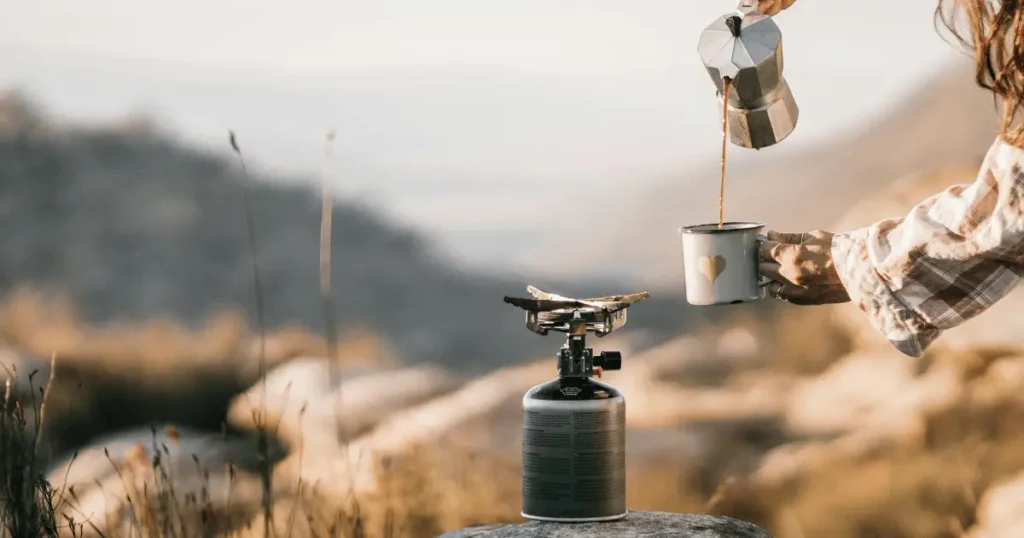
Setting up a camping kitchen needs careful planning and the right gear. Your outdoor cooking area should be efficient, compact, and ready for any meal. A well-organized camping kitchen can make your wilderness dining experience amazing.
Cooking Equipment and Utensils
Choosing the right cooking tools is key for a great camping kitchen. Look for lightweight, multipurpose items that save space and are very useful. Your essential toolkit should include:
- Compact camping stove with fuel
- Lightweight cookware sets
- Collapsible utensils
- Portable grill or cooking grate
- Durable cutting board
Storage Solutions and Organization
A camp kitchen organizer bag is your best friend for managing cooking supplies. These bags keep your gear sorted, protected, and easy to find. Look for ones with many compartments, water-resistant materials, and a compact design. This will make your camping kitchen more efficient.
Food Preparation Surfaces
Your outdoor cooking area needs stable, clean surfaces for preparing meals. Portable folding tables or dedicated camping kitchen stations are perfect. Choose options that are lightweight, easy to clean, and can handle outdoor elements. Make sure they are easy to set up and take down.
Choosing the Right Location for Your Camp Kitchen
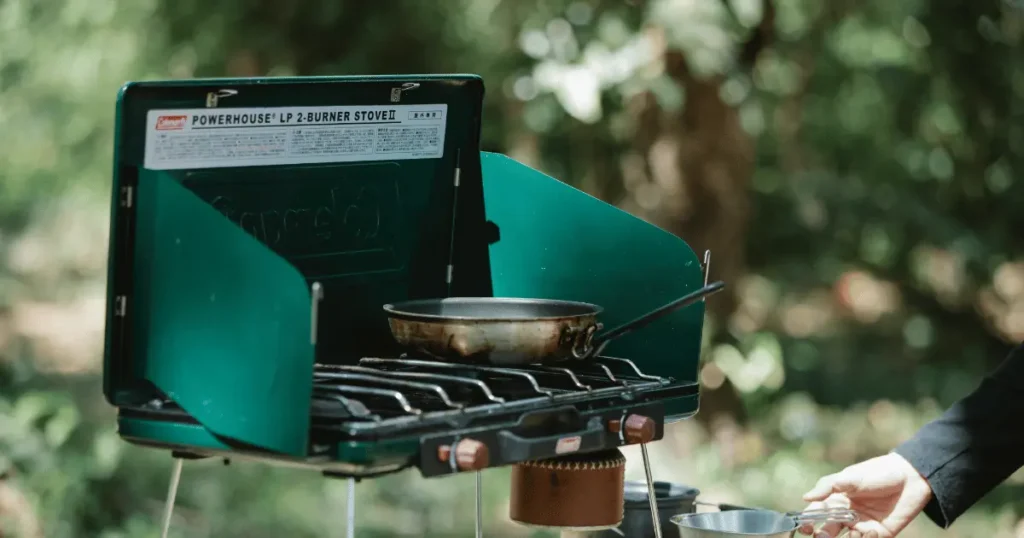
Finding the perfect spot for your camp kitchen is key. It greatly affects your cooking comfort and the overall camping experience. The right location balances functionality and safety.
When looking for the perfect spot, keep these important points in mind:
- Flat, stable ground for safe cooking surfaces
- Protection from wind and potential weather changes
- Proximity to water source for cleaning and cooking
- Safe distance from sleeping areas
Wind protection is crucial for your camp kitchen. Look for natural barriers like large rocks, dense trees, or small hills. These can shield your cooking area, keeping your stove stable and preventing fires.
Remember to be environmentally friendly when setting up your camp kitchen. Follow Leave No Trace principles by choosing locations that don’t harm the ground. Avoid areas with fragile vegetation or sensitive ecosystems. Use durable surfaces like rocky ground or established campsites to lessen your impact.
Safety is always the most important thing. Keep a 10-foot distance between your cooking area and tents to avoid fires. Make sure your camp kitchen has clear access and enough space for cooking and food preparation.
- Check ground stability before setting up
- Inspect surrounding area for potential hazards
- Bring portable ground cover if needed
By carefully choosing your camp kitchen location, you’ll create a safe, functional, and enjoyable outdoor cooking space. This will make your camping adventure even better.
Portable Kitchen Units and Tables for Outdoor Cooking
Choosing the right portable kitchen is key for a great camping trip. A good foldable camping kitchen turns your campsite into a neat cooking area. It’s both small and useful.
Today’s campers have many portable kitchen options. These units have important features that make cooking in the wild easier.
Foldable Camping Kitchen Designs
Foldable camping kitchens are great for outdoor cooking. They usually come with:
- Compact, lightweight design
- Simple setup and takedown
- Many storage spots
- Strong materials that last outdoors
Height-Adjustable Cooking Stations
Comfort is important while cooking outside. Height-adjustable tables make cooking easier. They help you avoid strain and make cooking better. Look for ones with strong legs and easy adjustments.
Weather-Resistant Materials
Choose a kitchen that can handle the weather. Look for ones with aluminum frames, waterproof fabrics, and rust-proof surfaces. They last longer and are reliable for your camping kitchen.
Get a top-notch foldable camping kitchen that fits your needs. It will make your camping meals better and more fun.
Smart Storage Solutions with Camp Kitchen Organizer Bags
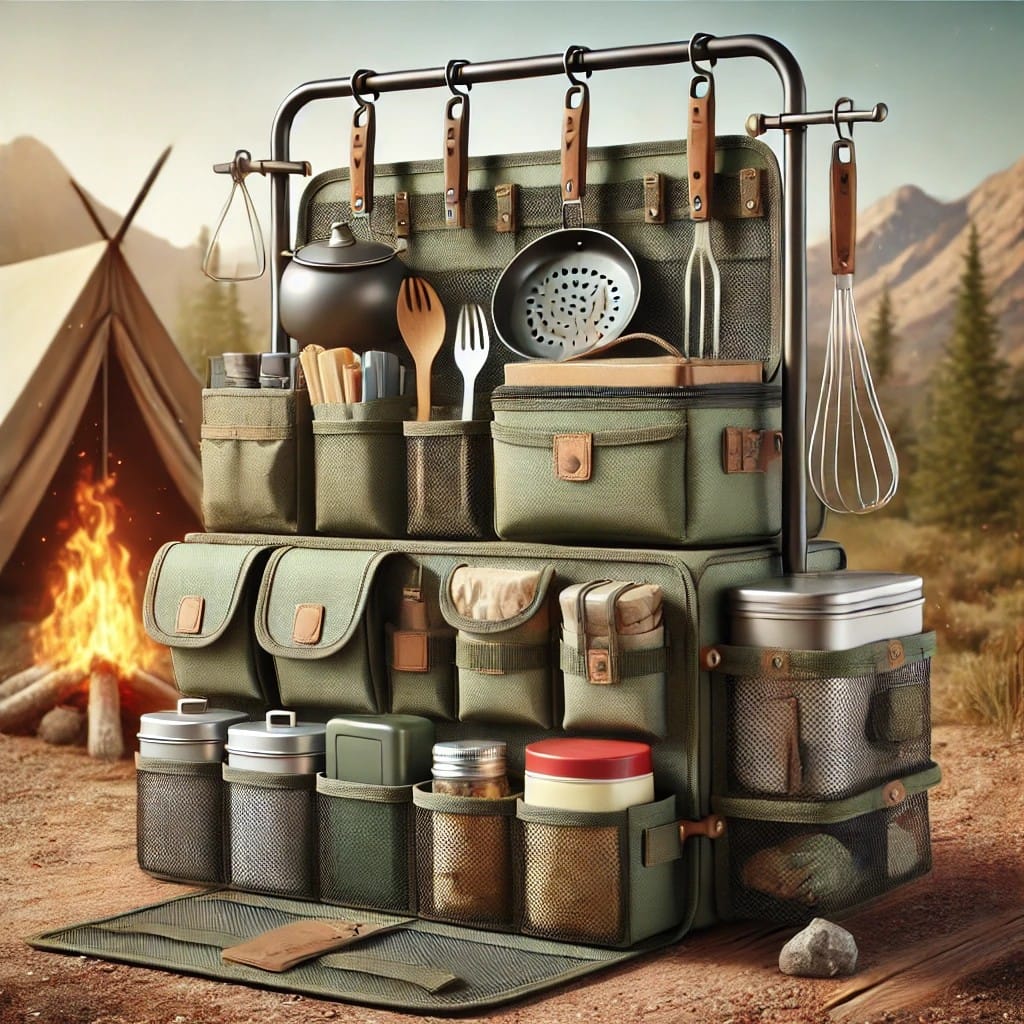
Camping trips need smart organization. A camp kitchen organizer bag is perfect for keeping cooking gear tidy and easy to find. These bags have special compartments for all your kitchen tools.
When picking a camp kitchen organizer bag, look for these important features:
- Durable, water-resistant materials
- Multiple compartments for different utensils
- Compact and lightweight design
- Easy-to-clean surfaces
A good camp kitchen organizer bag saves space and keeps things organized. Choose bags with padded handles and adjustable straps for easy carrying. Some bags even have thermal insulation to protect your tools from cold or heat.
Every trip is different, and so are your needs. For weekend camping, a small bag is great. But for longer trips, you might need a bigger bag with more storage. Think about how many people are in your group and what you’ll be cooking.
- Compact bags for solo travelers
- Medium-sized bags for couples
- Large organizers for family camping
Getting a good camp kitchen organizer bag makes cooking easier. It keeps everything you need right there. This way, you can enjoy nature and make great meals without hassle.
Setting Up Your Camping Kitchen: Step-by-Step Guide
Setting up a camping kitchen needs careful planning and organization. Your outdoor cooking area is key to a great camping trip. Make sure it’s functional and safe for all your cooking needs.
Layout Planning
A good camping kitchen starts with a smart layout. Think about these important points when setting up your outdoor cooking space:
- Choose a flat, stable surface for cooking
- Make sure you’re close to water for cleaning
- Keep your kitchen away from tent entrances
- Set up zones for cooking, prep, and storage
Equipment Placement
Placing your equipment wisely makes your kitchen more efficient. Group similar items together for better workflow:
- Put cooking stoves on stable, level surfaces
- Keep utensils and cutting tools handy
- Store coolers and food containers nearby
- Have a clean-up station with water, soap, and towels
Safety Considerations
Safety is crucial in your camping kitchen. Follow these important safety tips to keep yourself and others safe:
- Keep a clear area around cooking equipment
- Have fire extinguishers or water near cooking areas
- Store food safely to avoid wildlife
- Use proper food handling and sanitation
By following these steps, you’ll have a safe and functional camping kitchen. It will make your outdoor cooking better.
Must-Have Cooking Equipment for Your Outdoor Kitchen
Setting up the perfect camping kitchen needs careful choice of cooking gear. It should be both functional and easy to carry. The right tools can turn a basic setup into a top-notch outdoor kitchen.
Look for cooking equipment that’s versatile and small. Light and multi-use items save space and cut down on weight. They let you cook tasty meals anywhere outdoors.
- Portable Camping Stove: Choose a compact propane or butane stove with wind protection
- Nesting Cookware Set: Stackable pots and pans that minimize storage space
- Collapsible Silicone Utensils: Lightweight and easy to clean cooking tools
- Compact Cutting Board: Foldable or slim design for efficient food preparation
Your portable kitchen needs tough, heat-resistant gear. Brands like MSR, Coleman, and Camp Chef make durable options. Look for non-stick surfaces and even heat distribution for great cooking.
Think about adding special camping kitchen gadgets. Compact coffee makers, quick-heat water kettles, and multi-tool utensils can make cooking better. They don’t weigh much, either.
- Lightweight cast iron skillet for versatile cooking
- Compact water filter for safe drinking water
- Thermal cooking containers for keeping meals warm
Even on a budget, you can find great portable kitchen gear. Check prices, read reviews, and focus on durability. This will help you choose the best camping cooking equipment.
Food Storage and Preservation Methods
Keeping your food fresh and safe is key when camping. Proper storage can turn a good trip into a great one. Your camping kitchen needs careful planning to keep food fresh and prevent spoilage.
Cooler Management Techniques
Effective cooler management starts with smart packing. Here are some tips to make your cooler work better:
- Pre-chill your cooler before adding food
- Use block ice instead of cubed ice for longer cooling
- Pack frozen water bottles to serve as both ice and drinking water
- Create separate zones for raw and prepared foods
Dry Food Storage Solutions
Your camping kitchen needs good dry food storage to keep out moisture and pests. Choose airtight containers with tight lids. Plastic bins with snap-on covers are great for keeping crackers, cereal, and other dry goods fresh.
Bear-Proof Container Usage
In wilderness areas, keeping your food safe from wildlife is crucial. Bear-proof containers are a must. Pick containers that meet national park standards and can withstand curious animals. Always keep these containers away from your sleeping area, at least 100 feet from your campsite.
By using these food storage tips, your camping kitchen will stay organized, safe, and ready for tasty meals outdoors.
Water Management and Cleaning Station Setup
Setting up a good water management system is key for a great camping kitchen. You need to plan well to have clean water for cooking, washing, and staying clean on your trip.
First, create a water station in your camping kitchen. Use containers with tight lids to keep water clean. Choose strong, safe containers that can handle the outdoors.
- Pack collapsible water containers for easy storage
- Bring water filtration systems or purification tablets
- Include biodegradable soap for dishwashing
- Carry separate containers for clean and greywater
Make a smart cleaning area near your kitchen to protect the environment. Use a portable wash basin or a simple setup with two containers. This saves water and keeps your area tidy.
When you get rid of greywater, follow Leave No Trace rules. Strain food and scatter water at least 200 feet away from water sources and trails. Use a strainer to catch food and avoid attracting wildlife.
- Use cold water for initial cleaning
- Wipe dishes with paper towels before washing
- Sanitize surfaces with biodegradable cleaning solutions
Think about bringing water treatment options like portable filters or purification systems. These ensure clean drinking water and help manage your water use on outdoor trips.
Lighting and Power Solutions for Night Cooking
Setting up your camping kitchen at night needs good lighting for safety and fun. It can be hard to cook in the dark. But, the right power solutions can make your outdoor cooking better.
Solar-Powered Options
Solar lighting is a green way to light up your camping kitchen. Modern solar devices have many benefits:
- Rechargeable during daytime hiking or camp setup
- Environmentally sustainable power source
- Compact and lightweight design
- No need for extra battery replacements
Look for solar lanterns with different brightness levels and USB charging. Brands like Goal Zero and BioLite have great solar lighting for camping kitchens.
Battery-Operated Alternatives
If solar isn’t enough, battery-powered lights are great. Here are some tips for your camping kitchen:
- LED headlamps for hands-free illumination
- Portable LED lanterns with long battery life
- Rechargeable battery packs with multiple charging ports
- Compact flashlights with adjustable brightness
Choose battery-operated lights that are waterproof and durable. Look for ones with long battery life for steady light all trip.
Weather Protection for Your Camp Kitchen
Keeping your camping kitchen safe from the weather is key for a great outdoor cooking time. A good camping kitchen needs strong shelter to stay useful and comfy in all kinds of weather.
When picking weather protection for your camping kitchen, think about these important tips:
- Invest in a high-quality waterproof tarp or canopy
- Choose a foldable camping kitchen with integrated rain covers
- Use windbreaks to shield cooking surfaces
- Select weather-resistant materials for kitchen equipment
Foldable camping kitchens are great for weather protection with smart designs. Many have built-in rain flies and wind guards for a safe cooking spot. Look for ones with adjustable height and angle for better weather protection.
Wind and rain can mess up your outdoor cooking plans. To keep your camping kitchen safe, use strong stakes and guy lines to hold tarps and shelters. Waterproof storage containers will keep your cooking stuff dry and safe from moisture.
Pro tip: Carry lightweight, compact rain covers made for camping kitchens. These special covers add extra protection without weighing you down.
- Select multipurpose shelter solutions
- Prioritize lightweight and compact designs
- Check weather forecasts before your trip
By getting the right weather protection, your camping kitchen will stay useful and fun, no matter the weather.
Packing and Transportation Tips for Kitchen Gear
Getting your camping kitchen gear ready for transport needs careful planning. Camable kitchens for camping are great for saving space while packing. Look for compact, collapsible items that fit together well.
Use lightweight containers with tight lids to keep things from moving around. This also protects your delicate cooking tools.
Protect your gear by wrapping fragile items like utensils and dishes in soft towels or bubble wrap. Use strong storage containers that can handle rough roads. Many people suggest using hard-sided cases for camping kitchen gear to keep it safe.
Make a detailed list before you leave to make sure you have everything. Organize your kitchen tools by type – put cookware in one spot and utensils in another. Soft-sided bags with lots of pockets are perfect for keeping things organized.
Before packing, clean and dry all your gear to avoid moisture and mold. Pack heavy items at the bottom and light, fragile ones on top. Some camping kitchens come with special cases that make carrying easy.
With the right planning, your outdoor cooking gear will arrive safely and be ready for your next trip.
Tell Us What You Think: Your Input Matters
Super helpful for camping newbies!
I’m to camping, and this post was incredibly helpful in setting up my camping kitchen. The tips on packing essentials and organizing my gear were especially useful. Can’t wait for my next camping trip

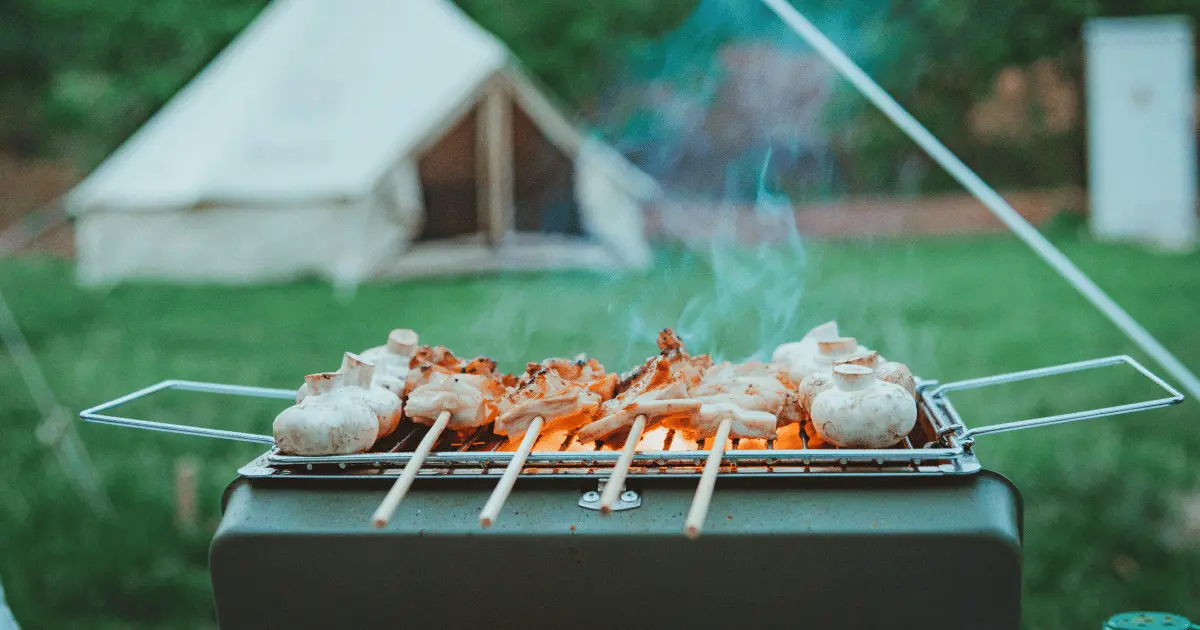
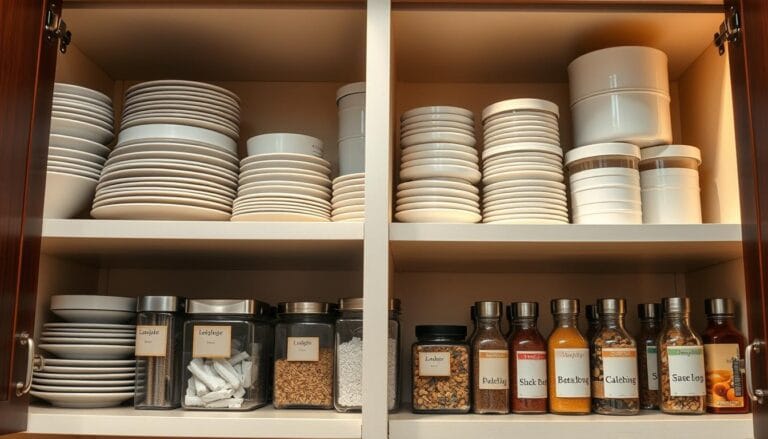
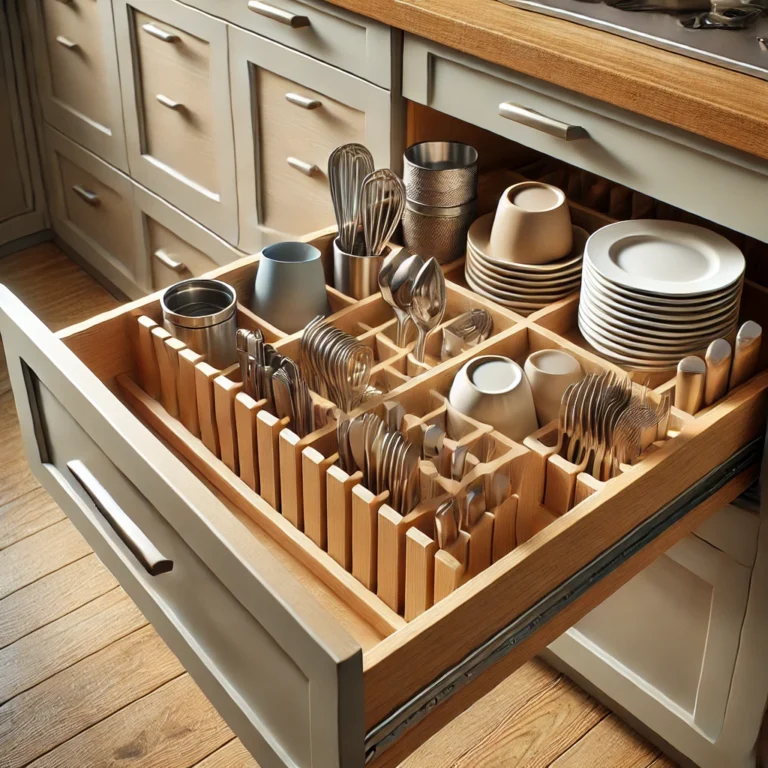
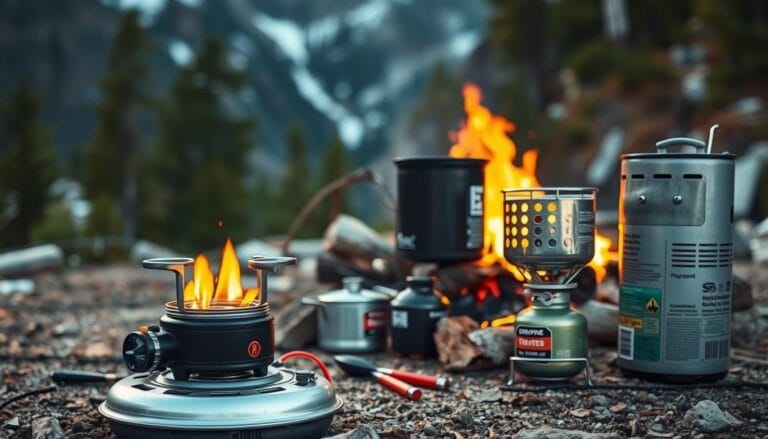
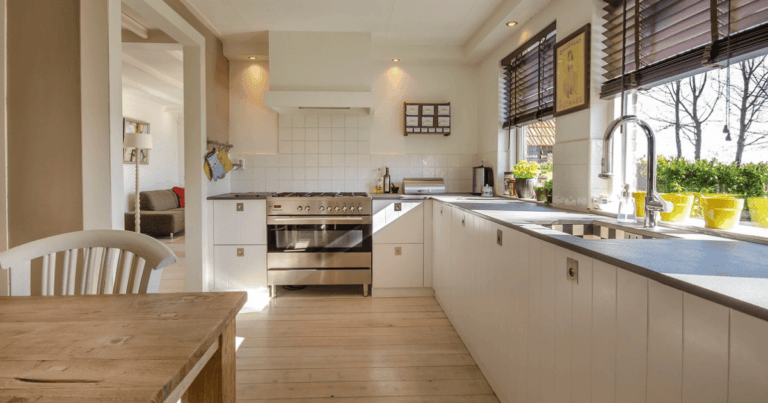

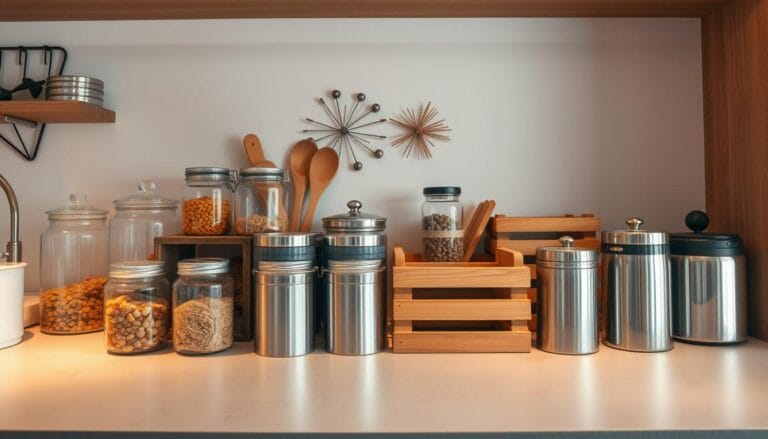
One Comment
Comments are closed.